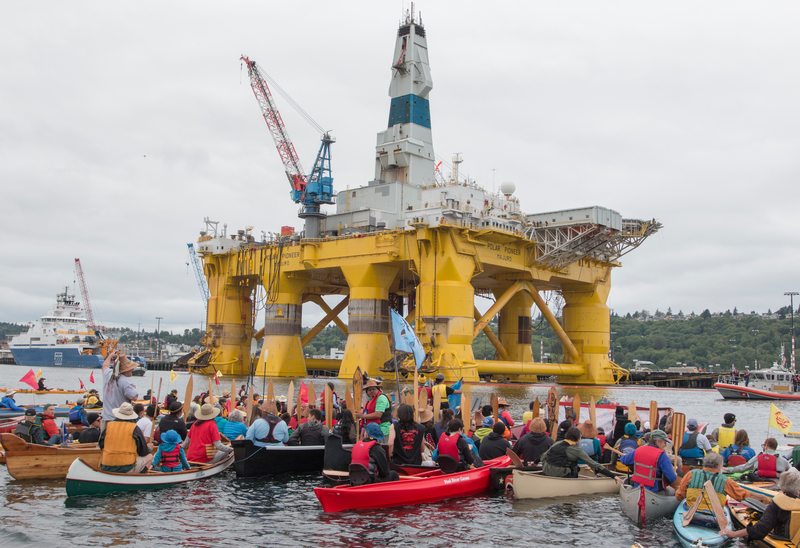We may say this every Friday, but this time we really mean it — this has been one hell of a long week.
Trump marks his first 100 days in the White House this weekend, and in an attempt to squeeze in just a few more attacks on our communities and environment, he went on an Executive Order blitz.
It started on Wednesday when he signed an executive order that ordered the Interior Department to review national monuments created in the past 20 years under the Antiquities Act. Not to be outdone by that executive order, Trump signed another executive order today that reviews protections from offshore oil and gas drilling, potentially opening up new drilling activity in the Arctic, Atlantic, and Pacific Oceans.
So what exactly do these executive orders mean? Before we explain the details of these moves by Trump, they both share a theme that reveal a blatant truth about this president — Trump has no respect for public lands, public spaces and public waters nor the people who depend on the protection of those areas. People in this country who cannot afford the membership fee at Mar-a-Lago want safe water they can drink and public lands for their communities to enjoy. Trump just wants to sell these areas off to the oil and gas industry with nothing but increased air and water pollution, a fossil fuel economy with no future and catastrophic climate change to show for it.
Now for the details on these orders and how you can resist.
Executive Order Reviewing Protections Under the Antiquities Act
What is it?
Trump signed an executive order ordered the Interior Department and Interior Secretary Ryan Zinke to review all national monuments created in the past 20 years that are at least 100,000 acres in size, back to President Bill Clinton’s designation of the 1.7-million-acre Grand Staircase-Escalante National Monument in 1996. The deadline for reporting back on this review ranges from 45 days from now to half a year.
The Antiquities Act is what protects these monuments, which President Theodore Roosevelt created in 1906 as a way for presidents to designate federal lands without Congress. These areas include everything from marine designations to monuments commemorating Civil Rights history.
What does it threaten?
The newest of these monuments that President Obama designated days before leaving office is the Bears Ears National Monument in Utah. Bears Ears was created by Obama after his administration heard from several Native American tribes that spent years in public meetings developing the plan. The Bears Ears monument is subject to the tightest review deadline. Secretary Zinke said the Interior Department should have a recommendation in 45 days.
This review impacts nearly 30 other areas now at risk of losing federal protections from the beautiful Seamounts Marine Park in Massachusetts to the Giant Sequoia region in California.
Executive Order Reviewing Protections from Offshore Oil and Gas Drilling
What is it?
Trump took a step towards opening up previously protected areas to offshore oil and gas drilling with the America First Offshore Energy Development order. His signature specifically directs the Interior Department to create a new five-year offshore plan that could look very different from the one President Obama passed. It also attempts to undo the Arctic withdrawal from offshore drilling although that will be much harder than Trump thinks — in other words, we’ll see him in court and a lawsuit is being filed by a powerful coalition of organizations.

It also clears the way for dangerous seismic testing, an explosive process that can harm and kill marine wildlife, and could rollback basic safeguards in place for oil spills like blowout prevention systems and well controls that were put in place after the deadly Deepwater Horizon spill.
What does it threaten?
Um, everything? Trump is tackling basic land, water, and community protections like a belligerent bull in a china shop. With this week’s orders, Trump threatens to carve up every last inch of land and water and slap a “for sale” sign for the next desperate fossil fuel bidder in line.
Not only do these senseless rollbacks immediately impact coastal communities and wildlife from the Atlantic to the Pacific to the Alaskan Arctic, they lock us into a fossil fuel future that we cannot afford. Renewable energy already has us on the right track to energy independence. Opening new areas to offshore oil and gas drilling will lock us into decades of harmful pollution, devastating spills like the Deepwater Horizon tragedy, and a fossil fuel economy with no future. Scientific consensus is that the vast majority of known fossil fuel reserves – including the oil and gas off US coasts– must remain undeveloped if we are to avoid the worst effects of climate change.
Now if only Trump listened to science to guide policy rather than his latest golfing buddy representing oil and gas interests.
How You Can Resist
Holing up at Mar-a-lago may protect Trump from an oil spill, but it will not protect him and his cabinet of one percenters from the millions of people in this country — from California to North Carolina — who will resist his disastrous policies.
You can start by telling the Department of Interior RIGHT NOW to listen to what the people want, not greedy fossil fuel barons. Call now at 855-636-8150 to demand it protect America’s national monuments and public lands and waters.
You can also demand that your representatives in Congress and your state leaders — mayors and governors- stand up for land and water protections. Show up at the next Town Hall (visit the schedule here) or schedule a meeting with your mayor to voice your concerns.
These moves by Trump are very scary. We have to do all we can to protect our communities today and for the future.



